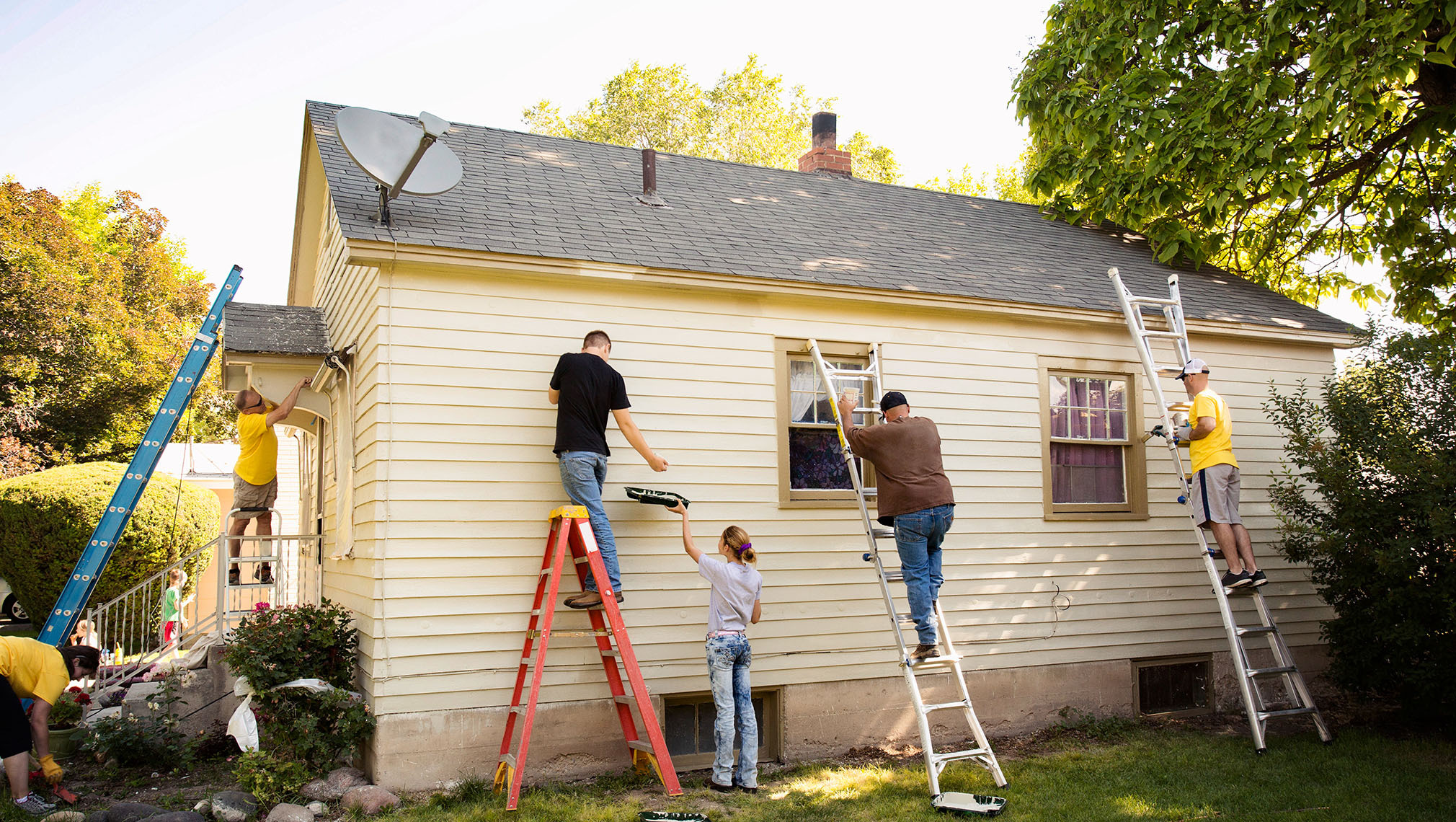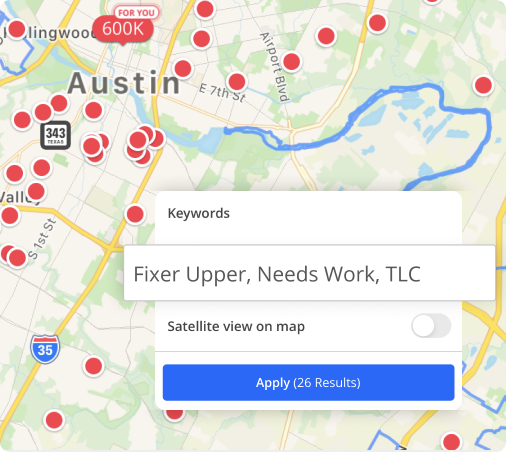
Searching for your dream home and wondering if it’s worth buying a fixer-upper and making it your own? Here’s what you need to know.
In this article:
- What is a fixer-upper home?
- Should I buy a fixer-upper home?
- How to find fixer-upper homes
- What to look for when buying a fixer-upper home
- How to buy a fixer-upper
- Financing options with fixer-upper loans

While the process of buying and renovating fixer-upper homes has increased in popularity due to fix-and-flip home improvement TV shows, not everyone is cut out for major renovation projects.
In fact, only 19% of homeowners said their home needed serious updates, and only 3% said their home needed a complete overhaul, according to the Zillow Group Consumer Housing Trends Report 2020.
Buying a fixer-upper involves purchasing the least desirable home on the block and overseeing its transformation. Whether you’re considering a fixer as an investment — and you plan to sell after construction is complete — or you’re fixing up a home to make it your own, there’s a lot to consider when buying a fixer-upper, from home price to construction costs to financing.
What is a fixer-upper home?
A fixer-upper is a home that needs repairs, but not so many that it’s uninhabitable or worthy of being torn down.
Fixer-uppers are usually offered for a lower price than homes in better condition, which makes them appealing to buyers looking to maximize their purchasing power or investors looking to flip the property and turn a profit.
Should I buy a fixer-upper home?
Most often, people buy fixer-upper homes because the cost of purchasing the home plus renovation costs may total less than what they’d pay for a comparable home in good condition.

Here are some of the key reasons buyers decide on buying a fixer-upper:
Reduced price
If you have your eye on a popular neighborhood, either for resale value or your own lifestyle, you may be able to get a better deal buying a fixer upper in your desired location and renovating it than purchasing an already-updated home.
Customizable improvements
When you purchase a fixer-upper, the sky’s the limit when it comes to fixtures and finishes (within your budget, of course). Renovating a fixer-upper can be ideal for buyers with very specific tastes or those who want more control over the aesthetics of their home. When buying a fixer-upper, you avoid paying for the renovations someone else completed, especially if you don’t like them.
Older home charm
The character of older homes isn’t easy to replicate. Buying an older home in need of some TLC can allow you to restore and maintain time period details, while bringing the home up to today’s efficiency, safety and comfort standards.
Make a profit
Whether you’re planning to flip or live in the home for a few years before selling, you may be able to turn a good profit based on the renovations you make. Your return on investment depends on the types of renovations you complete, the materials you use and the quality of the work. If profit is the goal, select popular home improvements in your market to increase property value and appeal to a wide variety of buyers.
Tax incentives
In some metropolitan areas, such as Philadelphia and Cincinnati, buyers who purchase a fixer-upper and renovate to improve the property value may be eligible for a tax abatement or credit.
How to find fixer-upper homes
Finding the right fixer-upper is all about where you look. Here are a few strategies for finding the right home. 
Want to find fixer upper homes in your area? Narrow down your search using the Keyword section of the Zillow app.
Search online: Use Zillow to search for homes below market value. You can search keywords such as “fixer upper,” “needs work” or “TLC” to narrow down potential properties.
Work with an agent: A local buyer’s agent should be able to help you find fixer-upper homes in your desirable neighborhoods. Well-connected agents may even be able to show you homes that haven’t hit the market yet, via word of mouth.
Search auctions, foreclosures and short sales: Distressed properties may be in fine structural condition but are sold below market value in order to offload them quickly. It’s important to note that these homes are usually sold as-is, and disclosures might not be available, so be sure you have enough extra money in your budget to cover surprise issues.
What to look for when buying a fixer-upper home
When shopping for a fixer-upper, prioritize the things you can’t change about a home (like its location), or things that would be too costly to change (like significant structural renovations). Here are key factors to consider:
Location
Location is the most important thing to look for, because it can’t be changed. Look for a fixer-upper in a desirable or an up-and-coming neighborhood in order to maximize potential resale value. Finding the right location will also ensure that you’re happy in the home. Pay attention to things that might be important to you, like school ratings, nearby parks and restaurants and commute times.
The home’s location will also play a part in determining your renovation budget and estimating the home’s post-renovation value. The quality of finishes and upgrades you select should be in line with comparable homes in the same neighborhood if your goal is to recoup costs on resale.
Layout and size
With a fixer-upper, you might be able to change the layout as you see fit, but pay attention to any design and layout ideas that would require removing load-bearing walls. This can be a costly exercise, and sometimes it’s just not possible. Home additions to increase square footage are also expensive and might not be allowed, depending on local zoning requirements and laws.
Home condition
There’s a difference between a fixer-upper and a home with significant structural defects. Structural and mechanical problems are a lot more expensive to fix than cosmetic ones. Be sure to hire a home inspector to gain knowledge of the home’s positives and negatives — hiring a home inspector is an invaluable step, even if you’re buying a home as-is. Here’s what should be on your home inspection checklist for a fixer-upper:
- Strong foundation
- Up-to-code electrical
- Proper plumbing
- Solid roof condition (should come with roof certification)
- HVAC and/or central AC
- Functional windows
Straightforward cosmetic updates
Prioritize homes that have outdated or worn out finishes that don’t appeal to the general public but can be updated affordably and without too much effort. Ideally, the fixer-upper you buy will only need cosmetic upgrades. Look for homes with:
- Peeling or dated paint (interior and exterior)
- Older bathroom fixtures and tile
- Dated kitchen cabinetry
- Laminate or tile countertops
- Stained carpeting
- Hardwood floors in need of refinishing
- Leftover belongings or trash that need to be removed
- Neglected landscaping
- Old or non-functioning appliances
How to buy a fixer-upper
Buying a home that needs work can be risky, because you won’t know the full condition of the home until you start tearing down walls. That’s why doing your due diligence on the property and neighborhood ahead of time is key.
Get a professional home inspection
When you put an offer on a house, be sure to include an inspection contingency. An inspection contingency allows you to back out of a deal and get your earnest money deposit back if the inspection reveals that the home has serious hidden defects.
Even homes marketed as being in “as-is condition” can be inspected — the only difference is with an as-is home, the seller is telling you that they do not want to make any repairs based on your findings.
The buyer is responsible for the cost of an inspection, which ranges between $250 and $700, depending on the size of the home and your location. In addition to a general inspection, you might also opt for specialized inspections for trouble areas. Common specialty inspections include pests, sewer lines, radon, lead-based paint and structural inspections. Costs for specialty inspections are similar to general inspections.
A structural inspection reviews the home’s structural integrity, but also lets you know of any natural hazards nearby that could impact the resale value or your own health and safety. You may also consider hiring a structural engineer to assess the property before you make an offer. It will cost between $500-$700 but could save you thousands of dollars in future foundation repairs.
Hire an architect and general contractor
An architect can create a new layout for a home, create plans and blueprints and tell you what is and isn’t possible. Some cities require you to submit architectural plans to acquire home permits, making an architect a necessity. The average cost for an architect is around $5,000, depending on the scope of your project.
Your home inspector should be able to give you a rough estimate of what it would cost to adequately repair problem areas that come up in an inspection, but since they’re not the one who will be doing the work, it’s best to get a more accurate quote from a contractor. Whatever they quote you, add a 10% contingency for any problems that come up along the way. Be sure to get quotes from a few contractors and do your due diligence in checking their licensing and customer reviews.
Budget for improvements
Working with your contractor, be sure that your budget takes into consideration all applicable costs. Don’t forget to include:
- Permit fees, if applicable
- Cost of materials, like flooring, paint, light fixtures, cabinetry, countertops and hardware
- Cost of labor, including general contractors, plumbers, electricians and inspectors
- Cost of living during renovations, if the home will be uninhabitable during the project
Know your limits
Above and beyond the financial concerns, you also need to gauge your tolerance for a major renovation project, especially if you plan to save money by doing some of the work yourself. Home renovations are not as easy as they look on TV and if it’s your first time, a lot can go wrong. Even if everything goes right, there’s a lot of hassle involved in a large-scale construction project. You’ll have to live in a construction zone or move elsewhere temporarily, while still paying all the carrying costs for the home. Finally, the project could take a lot longer than you expect due to supply-chain issues that have affected the cost and availability of many construction materials.
Financing options with fixer-upper loans
You can purchase a fixer-upper with a traditional conventional loan then pay for all the improvements out of pocket. Or, you can get a fixer-upper mortgage that’s designed to help you finance both the house itself and the renovations. Common types of home loans for fixer-uppers are:
FHA 203(k) standard
An FHA 203(k) Standard loan finances the purchase and renovation of a primary residence. Here are the key requirements:
- Minimum credit score of 500 with a down payment of 10%, or a credit score of at least 580 with down payment of 3.5%
- The total cost of the loan must fall under FHA mortgage limits in your area
- No luxury improvements (like pools) are allowed, but structural work is allowed
- Requires a HUD consultant to approve the architectural plans, oversee payments to contractors and review inspections to ensure the home meets structural integrity and energy efficiency standards
- There are limits on how soon you can resell (not within 90 days)
- The contractor is paid out of an escrow account managed by the lender
FHA 203(k) streamlined
This financing option has similar requirements as the FHA 203(k) Standard, but it’s meant for simpler, cosmetic renovation projects, as it has a spending limit.
- Minimum credit score of 500 with a down payment of 10%, or a credit score of at least 580 with down payment of 3.5%
- For cosmetic upgrades under $35,000
- There are limits on how soon you can resell (not within 90 days)
- The contractor is paid out of an escrow account managed by the lender
HomeStyle loan
A HomeStyle loan is a combination home loan and home improvement loan, guaranteed by Fannie Mae.
- Minimum credit score of 620; minimum down payment of 3 or 5%, depending on a few factors like owner occupancy, first-time home buyer status and income
- Allows for other improvements that aren’t covered under an FHA 203(k), like pools and landscaping—but note that all improvements need to be “permanently affixed to real property (either dwelling or land)”
- The contractor is paid out of an escrow account managed by the lender
- You must use a certified contractor
CHOICERenovation
A CHOICERenovation loan is a combination home loan and home improvement loan, guaranteed by Freddie Mac.
- You can finance renovations that cost up to 75% of a home’s value
- Money can be used for upgrades that prevent natural disasters
- You can DIY the work and get a down payment credit
- Requires multiple appraisals to ensure you’re upholding the terms of the contract and that the agreed-upon renovations make the home meet its estimated value
